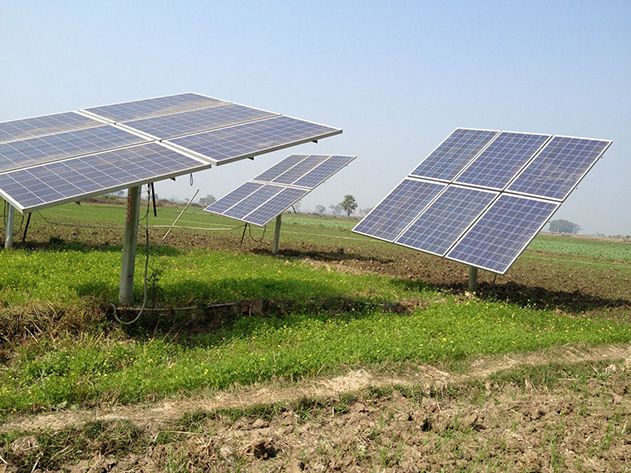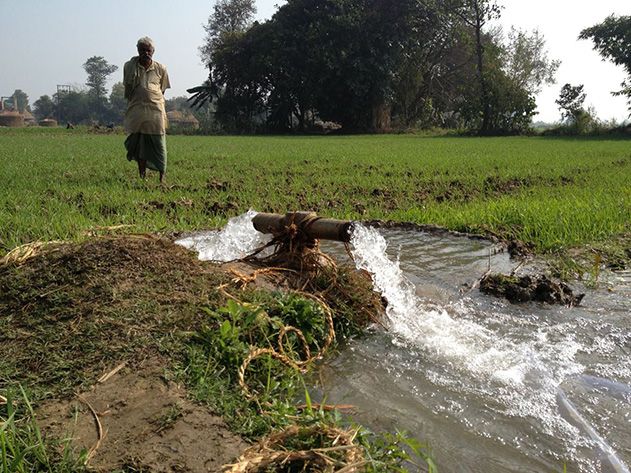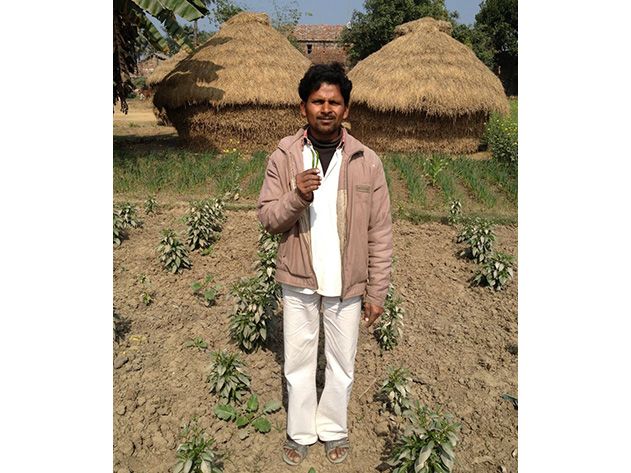How Solar Can Save India’s Farmers
Water pumps powered by the sun could solve a host of problems for rural farmers and the nation’s power grid
/https://tf-cmsv2-smithsonianmag-media.s3.amazonaws.com/filer/India-Solar-Farmers-631.jpg)
Ravi Kant, a rice and wheat farmer in his 30s, lives in Bihar, just south of Nepal and one of the poorest states in India. Kant used to perform an intricate ritual when rains alone couldn’t provide enough water for his crops: He would rent a diesel pump from town, shoulder it on a bamboo sling and carry it to a corner of his property where he could drench one of his flat fields with water from an underground aquifer. Then he would move it to another quadrant, and another. "The discharge [of water] from the diesel pump was never strong," Kant recalled. "Add to that the time and hassle to rent a van, go to the town and buy diesel.”
But life recently became much easier for Kant: His fertile acreage near the banks of the iconic river now has its own 7.5-horsepower water pump powered by six six-foot-square solar panels. Watering his fields is as simple as walking a plastic hose past the huts where the women dry cow patties for stove fuel. When the sun shines, the farmer can summon water from the ground whenever he wants, and even on cloudy winter days he can irrigate for at least two hours.
A consensus is building that India needs millions more farmers who, like Kant, run their irrigation on sunshine. The country is home to 25 million agricultural water pumps, more than anywhere on earth. Whether they draw their power from the country’s rickety power grid or from diesel-fueled generators, the pumps cause a host of problems. They are sucking aquifers dry, draining the government treasury and farmer’s pockets, and adding to the country’s burgeoning carbon emissions levels.
A growing number of government officials, aid workers and entrepreneurs believe that if any sector is ripe for solar power in India, it is the legions of agricultural irrigation pumps, because the benefits could add up so quickly.
“In my view, India should stop doing all other solar and just focus on giving farmers a solution for their needs,” said Pashupathy Gopalan, a managing director of SunEdison, an American firm that is one of India’s largest developers of big solar farms and rooftop solar panels. “The farmers will be happy, and once the farmers are happy, the politicians will be happy because the farmer tells his family how to vote."
To know how a solar pumpset, as it’s called, can make such a difference, it’s worth taking a moment to understand the strange burden that watering crops places on the Indian economy. About 18 million of the country’s 25 million pumpsets are tied to the national electric grid. India’s planning commission estimates that farming accounts for about 15 percent of gross domestic product but the sector consumes some 25 percent of the nation’s electricity, mostly from powering irrigation pumps. Utilities provide this power at a huge loss; electricity for farmers is usually free, or nearly so, costing only a couple of pennies per kilowatt.
It’s been this way for decades, the legacy of a country that is quickly urbanizing but whose self-image -- and nearly 70 percent of its population -- is still rooted in the countryside. The policy comes at a high cost, both in energy and money. The power lines experience transmission losses of 30 to 40 percent on their long route to customers who pay almost nothing. "Every watt sold to a rural customer is a loss to the bottom line," explained Srinivasan Padmanaban, a senior energy advisor to the U.S. Agency for International Development (USAID) in New Delhi.
This burden is taking its toll on the rest of India. Most state electricity boards, the rough equivalent of U.S. utilities, are operating in the red, and the nation’s power system frequently falters under the demand pressures of the fast-growing country. In July 2012, more than half of India’s population, 670 million people, experienced the world’s largest blackout ever. Smaller, rolling blackouts are common, even in some of India’s largest cities, spurred on by an outdated power grid, electricity theft, chronic shortages of fuel and the rising cost of imported coal and petroleum. Easing energy demand is a top priority.
And if the flickering power grid is a headache for utility officers and city dwellers, it is an obstacle of another kind for the farmer, sometimes a deadly one. Farmers get electricity, but often for only a few hours a day—or, rather, the night, when no other customers need it. This means that many farmers stumble out of bed and irrigate their fields in the dark. India is home to many venomous snakes like cobras and vipers, and it is fairly common, Gopalan said, for a farmer to meet his end with a snakebite.
These exhausted farmers who depend on short bursts of free electricity are not the best stewards of the nation’s diminishing supply of groundwater. The system incentivizes the farmer to use as much water as he can when he can get it. Thus, many farmers gravitate toward crops that require flooding, like rice and wheat. But these commodities offer farmers the lowest of profit margins. Global consulting firm KPMG estimates that solar pumps, which give a farmer the leisure to pump water only when he needs it—and can see it—could increase agricultural income by 10 to 15 percent by letting farmers switch to more profitable crops such as tomatoes and potatoes.
Converting all of India’s electric water pumps to solar would appear to make imminent sense, but the economic argument for solar is even more compelling for diesel-powered pumps. Solar-powered water pumps, which include a power source and expensive electronics, currently cost upwards of $6,000, whereas a pump that runs on electricity or diesel can be had for as little as $500. That’s an enormous difference in a country with a per capita yearly income of only $1,200. Farmers who get their electricity for free would probably rather save their money and risk the cobras. But for the 7 million diesel-using farmers like Kant, most of whom have no electrical connection and have had no choice but diesel pumps, they can spend up to 35 or 40 percent of their income on diesel. And that amount is rising because the country is phasing out its subsidy on the fuel.
“The costs of running a diesel pump are very high,” said a grizzled neighbor of Kant’s, who went by the sole name of Ayodhya. As we watched water tumble onto his field from his solar-powered pumpset, Ayodhya explained, “for a farmer who owns one bigha of land [about 70 percent of an acre], the diesel pump has to be run four hours a day. The pump consumes two liters of diesel an hour. That is 320 rupees [U.S. $5.55] per hour.”
Energy subsidies, however, aren’t necessarily going away -- they’re instead moving toward solar. "We see a huge market for solar pumps in India," said G. Prasad, head of off-grid solar projects for the Indian Ministry of New and Renewable Energy, which is offering to pick up 30 percent of the cost of solar pumpsets. Ten states have also added their own subsidies. Rural energy independence appeals to local politicians who can steer money to their constituents, as well as ministerial bean counters who see a potential for savings. KPMG estimates that if the government purchased 100,000 solar pumps, India could save $53 million a year in diesel imports.
The prospect of government largesse, combined with millions of potential customers, has global solar and pump manufacturers, from SunEdison to Germany’s Lorentz to Denmark’s Grundfos, running toward the Indian market. Kant’s pump was installed by Claro Energy, an Indian startup that is competing with the big multinationals. “It’s a tremendous opportunity because of the sheer size of the country, the sheer size of the population,” said Melanie Natarajan, head of Asia-Pacific water operations for Franklin Electric, an American pump maker.
Ravi Kant couldn’t be happier with his solar-powered pump -- and not just because subsidies have driven his power costs down to zero. Instead of wrestling with a diesel-powered pump in front of his cows, he adjusts the panels a few times a day to point them toward the sun, and every few days washes the dust off. “We can grow a third crop because of the solar pumps. We grow either dal or maize. Our annual income is up by about 20,000 rupees [U.S. $347] per year,” he said.
Solar panels have been known to work for two decades and more. If they do, the blue-tinted solar panels will empower another generation – Kant’s children -- to water their own crops with sunshine.
Sanjoy Sanyal contributed to the reporting of this story.
Disclaimer: Pashupathy Gopalan is a distant cousin by marriage of the writer.


